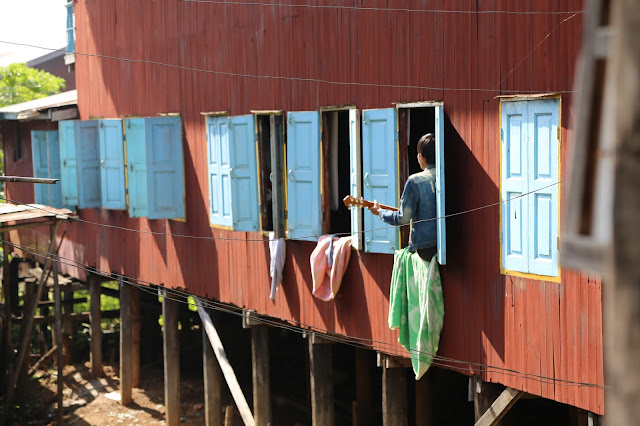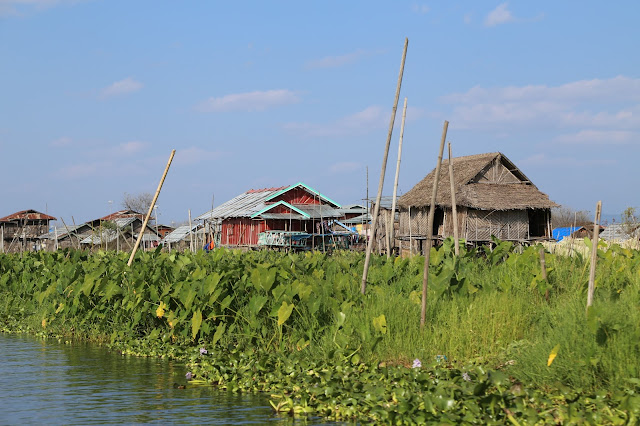The iconic images of Inle Lake
We have a perfect little bungalow retreat away from the noise and dust of Nyuang Shwe town on the edge of a shallow freshwater mountain lake. Sitting at 2900 feet, Inle Lake, or
Inle Sap is the second largest in Myanmar, flooding almost 45 square miles. The lake is host to several endemic species and recently became part of the World Network of Biosphere Reserves. Despite it's newly protected status we were advised before we came not to eat fish from the lake or any raw vegetables.

Deforestation of surrounding hills and commercial agricultural farms are filling the lake with runoff silt and agrochemicals. At an average depth of only 7 feet, the agricultural nutrients encourage rampant growth of algae and weeds that further compromise the lake's water flow and the invasive non-native water hyacinth clog feeder streams with its beautiful blossoms, robbing native plants and animals of nutrients and sunlight. Many of the stilted settlements on the lake have floating gardens which over time become solid land. Pesticides from the floating gardens and raw sewage from these villages contribute to poisoning of the shallow lake.
 |
| tourist boats |
But to us unknowing tourists that flock to Inle, these polluted facts are overshadowed by the superficial beauty of the area and by the wonderment inspired by the aquatic villages. Infrastructure has popped up all over the lake to cater to the throngs of sunburned foreigners with their giant cameras. Stilted resorts, silversmith workshops, cigar factories, lotus weavers and long-necked ladies serve as prime bait for wealthy tourists.

Since the country only recently re-opened to foreigners, pretty much everyone who visits Myanmar goes to the same places and this is our first full on encounter with the Myanmar tourist circuit. We are no different from the rest and are consciously lured into the tourist trap by our unchecked curiosities.
We ride creaky beach cruisers to explore Nyuang Shwe town, navigating potholed
side roads and little dirt trails, waving at children playing in the street and
women hanging laundry in their front yards. The square houses are stilted with
shuttered windows open to the breeze. Potted plants sit anywhere there is space
and men lounge in hammocks in the shaded living rooms.
 |
| downtown Nyuang Shwe |
 |
| The main waterway leading from Nyuang Shwe to the big water |
 |
| fishermen with their baskets on Inle lake |
 |
| a fisherman steadying himself with his oar so he can cast his net |
 |
| one of several aquatic villages on the lake |
 |
| lake stupas |
 |
| obligatory stop at one of the silversmith workshops |
 |
| handmade silver fish with ruby eyes mined in Myanmar |

 |
| The Kayan people are an ethnic minority group in Myanmar. According to their tradition, girls begin wearing brass coils wrapped around their necks as early as age two. As the women get older, the coils are replaced by longer ones; the weight of the metal pushes the collar bones down, deforming the clavicle and compressing the rib cage, creating the illusion of a longer neck. This cultural symbol of beauty has become a source of income for the Kayan tribes who collect fees from curious tourists. |
 |
| The side show circus of long-necked ladies. These shy women were surrounded by a group of camera clicking tourists, forced to take part in a humiliating zoo like show in exchange for the tips that help sustain their families and tribe. I felt horrified to be a part of what I considered blatant exploitation and hid around the corner while Michael shot these beautifully depressing images. |
 |
| a new house under construction |
 |
| school soccer match |
 |
| caught it right before it hit the water |

 |
| the village's potable water tower |
 |
| lotus harvest and floating gardens |
 |
| a well dressed evening fisherman |
 |
| back to the docks |
 |
| early morning mist at the edge of the lake |
 |
| goodbye Inle, off to Bagan |
 Deforestation of surrounding hills and commercial agricultural farms are filling the lake with runoff silt and agrochemicals. At an average depth of only 7 feet, the agricultural nutrients encourage rampant growth of algae and weeds that further compromise the lake's water flow and the invasive non-native water hyacinth clog feeder streams with its beautiful blossoms, robbing native plants and animals of nutrients and sunlight. Many of the stilted settlements on the lake have floating gardens which over time become solid land. Pesticides from the floating gardens and raw sewage from these villages contribute to poisoning of the shallow lake.
Deforestation of surrounding hills and commercial agricultural farms are filling the lake with runoff silt and agrochemicals. At an average depth of only 7 feet, the agricultural nutrients encourage rampant growth of algae and weeds that further compromise the lake's water flow and the invasive non-native water hyacinth clog feeder streams with its beautiful blossoms, robbing native plants and animals of nutrients and sunlight. Many of the stilted settlements on the lake have floating gardens which over time become solid land. Pesticides from the floating gardens and raw sewage from these villages contribute to poisoning of the shallow lake.




























































No comments:
Post a Comment